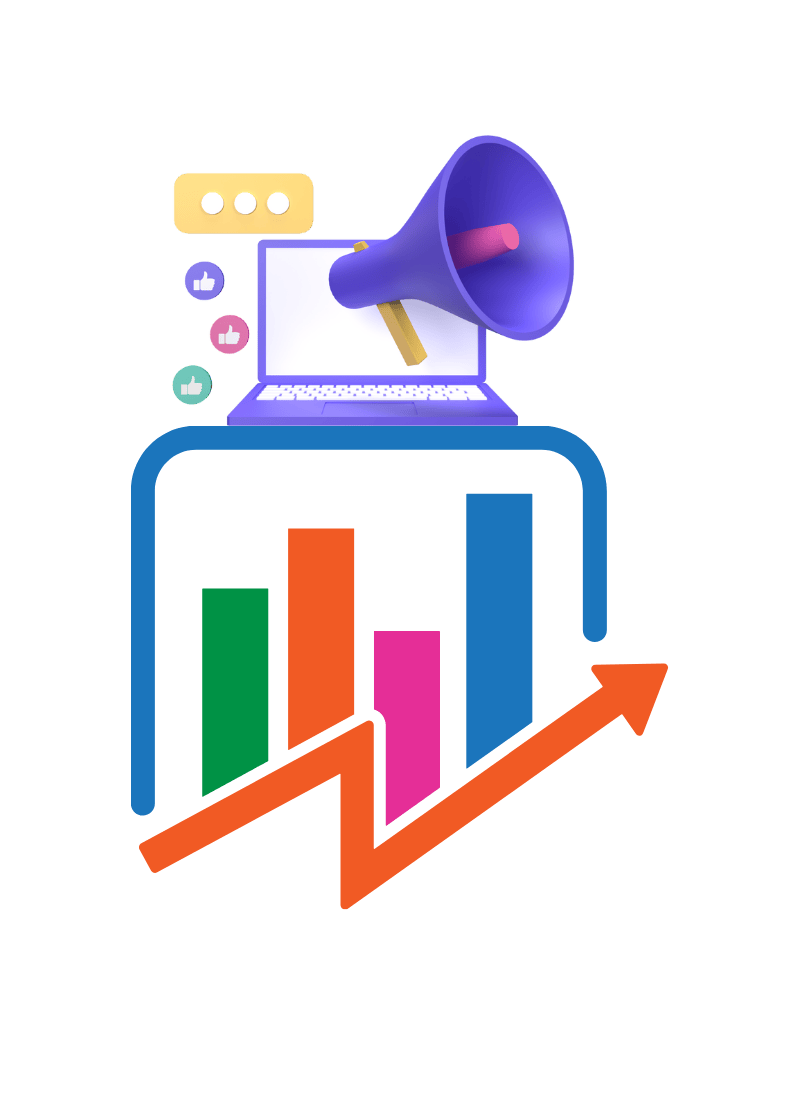Email Marketing for IT Services is a powerful channel when done right, offering one of the highest ROIs in digital marketing. Instead of blasting generic messages, successful IT firms send segmented, personalized campaigns to prospects and clients with content that solves real problems. As HubSpot notes, segmented emails can achieve about 30% more opens and 50% more clicks, and email stands out as the #1 ROI source for 59% of marketers. We’ll explore proven strategies that work: the campaign types that deliver results, how to engage busy tech audiences, metrics to watch, and common pitfalls to avoid.
Why Email Marketing for IT Services Works
Email marketing is a “game-changer” for IT service providers, combining high ROI with personalized outreach. By sharing useful content in focused campaigns, IT firms can attract new leads and guide them through the sales funnel. For example, a whitepaper on a common IT challenge can capture a prospect’s contact, and follow-up emails can nurture that lead toward a sale. Equally important, email keeps existing clients engaged: regular updates and insights (like best-practice tips or service announcements) build trust and loyalty. In short, email helps IT companies stay top-of-mind, strengthen client relationships, and convert readers into customers.
Proven Email Campaign Types for IT Services
Different emails serve different goals in an IT marketing strategy. Common effective campaigns include newsletters, lead-nurturing drips, onboarding series, and targeted promotional or re-engagement emails. Each type has its purpose, strengths, and drawbacks. For clarity, the table below compares several IT-focused email campaign types, their uses, pros, cons, and examples:
| Campaign Type | Purpose / When to Use | Pros | Cons | Example |
|---|---|---|---|---|
| Newsletter | Regular updates on industry news, tips, and company announcements. Builds brand awareness. | – Establishes authority and keeps audience engaged. – Easy way to share insights and highlight services. | – Can be ignored if content isn’t relevant.- Requires consistent, high-quality content. | Monthly IT security tips newsletter featuring a recent cyber threat overview, case study, and upcoming webinar. |
| Lead Nurturing (Drip) | Automated series for new leads or trial sign-ups to educate them gradually. | – Moves leads through the sales funnel automatically. – Delivers targeted content based on interest. | – Requires careful planning & setup. – Overdoing it can annoy prospects if too frequent. | A 5-email drip: Welcome → Challenge-focused article → Case study → Solution guide → Special offer. |
| Onboarding / Welcome | Sequence for new clients or subscribers to introduce your services and resources. | – Improves client satisfaction by guiding them. – Increases adoption and reduces churn. | – Needs coordination with sales/service teams. – Overkill if service is extremely simple. | Onboarding sequence: “Welcome to [Your Service]” → Setup guide with screenshots → Training resources → Quick check-in. |
| Promotional / Upsell | Announce promotions, new services, or cross-sell opportunities to customers. | – Can drive additional revenue and showcase full service range. – Reminds clients of complementary services. | – Risk of being seen as too salesy. – Must provide clear value (discounts, limited-time deals). | Email to clients: “Upgrade to Premium Support at 20% off” or “Introducing our new cloud backup add-on.” |
| Re-engagement | Target inactive subscribers or clients with special content/offers. | – Recovers lost contacts and cleans your list. – Can reignite interest if done cleverly. | – May lead some to unsubscribe. – Hard to stand out in a crowded inbox. | “We Miss You” email with updates they’ve missed and an exclusive report to renew interest. |
Each campaign should include a clear call to action. For example, a newsletter might link to a blog or invite readers to an event, while a drip campaign might lead to a demo sign-up. Planning these campaigns on a content calendar ensures consistency without overwhelming your audience.
Segmenting Your Audience for Personalization
One of the keys to effective email marketing is segmentation. Instead of emailing all subscribers the same message, break your list into meaningful groups and tailor content accordingly. As ChannelPro advises, segmenting by common traits ensures emails “fit each group’s special needs” and leads to more people reading and responding. For IT firms, useful segmentation criteria might include:
- Industry or Role: Customize your message for different sectors (e.g. healthcare vs. finance clients).
- Company Size or Tech Stack: SMBs have different IT needs than enterprises, or cloud users vs on-premises users may require different pitches.
- Engagement Level: Separate active clients from cold leads to send appropriate follow-ups or re-engagement offers.
By segmenting your audience, you can craft more relevant subject lines and content. Personalization then goes a step further: use dynamic fields (first name, company name, product used) and reference known pain points to show you understand their needs. HubSpot reports that 78% of marketers use subscriber segmentation and 72% use personalization as core strategies. When done right, these tactics make recipients feel the email was made just for them, greatly improving open and click rates.
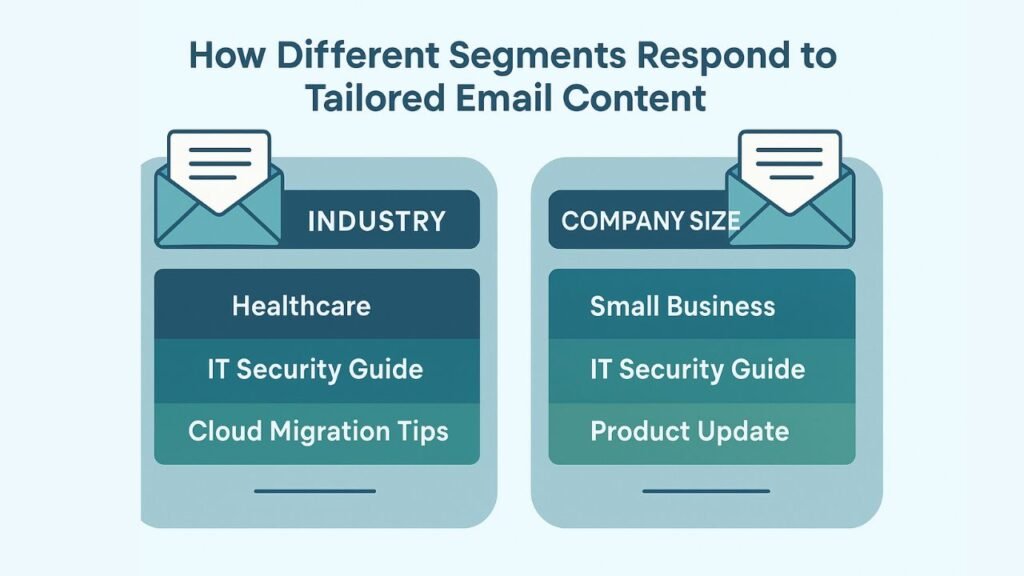
Creating Engaging Content and Strategies
Deliver value in every email. IT audiences are typically savvy, so your content should be useful, educational, or insightful – not overly salesy. Good content ideas include how-to guides (e.g. “5 tips to secure your network”), case studies of client success, technical whitepapers, or invitations to webinars. Using visuals and interactive elements can boost engagement: emails with images have a ~30% open rate versus ~22% for text-only, and adding video can increase click-through rates by up to 65%. For example, embed a short product demo or infographic in your email, or even a screenshot of analytics to illustrate a point. Clear calls to action are crucial – each email should guide the reader on what to do next (download, register, call, etc.).
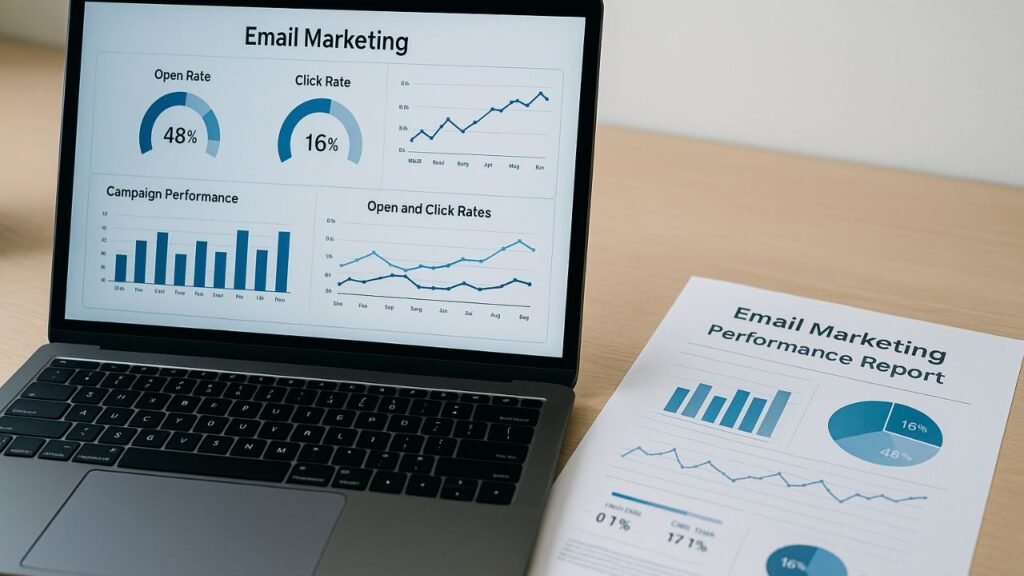
Timing and frequency matter too. Avoid emailing too often; quality beats quantity. Use an email schedule (e.g. weekly newsletter or monthly digest) and stick to it. Experiment with send times (some IT professionals prefer early-morning reads, others after-hours) and consider A/B testing subject lines and send times to see what yields higher engagement. As ChannelPro notes, running small tests (like subject lines or button placement) “helps you make smart choices” and continuously improves results. In practice, start with one or two core campaigns (like a monthly newsletter and a welcome series) and expand from there as you see what resonates.
Metrics and Tools for IT Email Campaigns
Tracking the right metrics is key to making email marketing work. Key metrics include open rate (the percentage of delivered emails that recipients opened) and click-through rate (CTR) (the percentage who clicked a link or CTA). Mailchimp explains that open rate is a gauge of how compelling your subject line and preview text are, while CTR indicates how relevant and engaging the content was. In B2B IT markets, good open rates often range 20–30%, but averages vary – for context, HubSpot notes an overall industry average around 42%. More important than any benchmark, however, is improving your own numbers over time.
Beyond opens and clicks, track actions that tie to your goals. If your objective is leads, measure how many email recipients request demos, quotes, or consultations. If retention is a goal, watch renewal or upsell rates. According to HubSpot, the most critical outcome is that “the right people are opening your emails” and taking desired actions. Use tools like Mailchimp, HubSpot, or Campaign Monitor to automate tracking – these platforms provide dashboards for opens, clicks, unsubscribes, and more. They also make A/B testing easy, so you can compare subject lines, content blocks, or calls-to-action. (For example, try two subject lines in a small batch and send the winner to the rest of your list.)
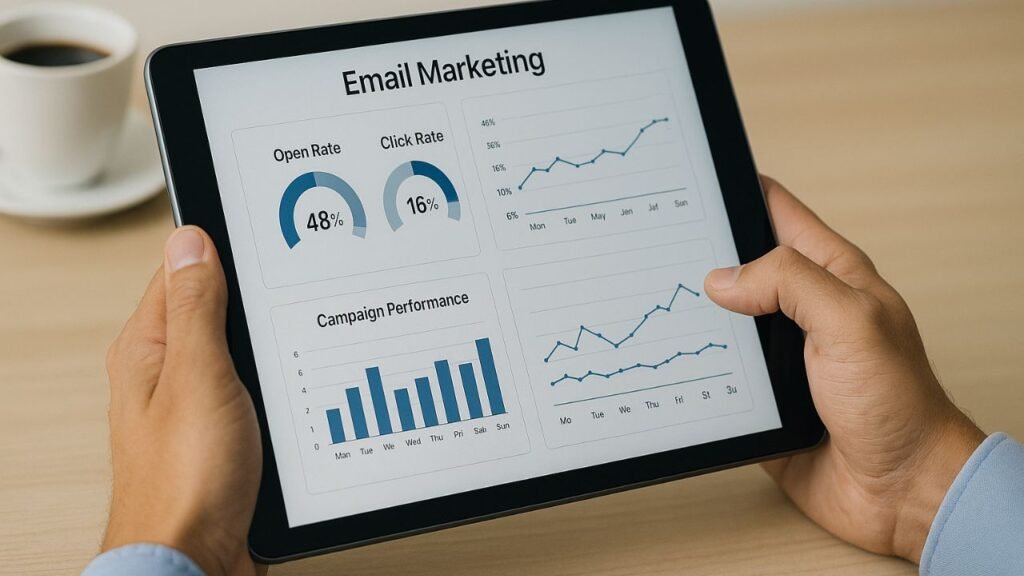
Finally, watch list health metrics: a high bounce rate or spam complaints will hurt deliverability. Clean your list regularly to remove invalid or stale addresses. Ask subscribers to whitelist your email address, and avoid spam-trigger words or excessive punctuation. In fact, nearly half of all marketing emails get sent to spam according to research, so following these best practices is crucial to reaching the inbox.
Why Email Marketing Matters for IT Services
Before diving into our recommendations, it’s essential to understand why email marketing is particularly crucial for IT services. Unlike other industries, IT companies often deal with complex solutions that require education and trust-building. Email marketing allows you to share technical insights, case studies, and industry updates while maintaining regular contact with prospects who may have lengthy decision-making cycles.
Moreover, IT professionals prefer detailed, information-rich communications that demonstrate expertise. Email campaigns can effectively deliver whitepapers, product updates, security alerts, and educational content that positions your company as a thought leader in the technology space.
5 Best Free Email Marketing Tools for IT Services: Complete Guide for Tech Companies
Email marketing remains one of the most cost-effective strategies for IT service providers to nurture leads, showcase expertise, and build lasting client relationships. However, finding the right platform that balances functionality with budget constraints can be challenging. The good news is that several powerful email marketing tools offer robust free plans specifically suited for IT companies looking to establish their digital presence without breaking the bank.
In this comprehensive guide, we’ll explore the five best free email marketing platforms that cater specifically to IT services, analyzing their features, limitations, and unique benefits. Whether you’re a startup offering cloud solutions, a cybersecurity firm, or a software development company, these tools will help you create professional campaigns that resonate with your technical audience.
1. Mailchimp: The Industry Standard for Email Marketing for IT Services
Mailchimp stands out as one of the most popular free email marketing platforms, making it an excellent choice for IT service providers seeking reliability and comprehensive features. With its user-friendly interface and robust functionality, Mailchimp has become the go-to solution for businesses across various sectors, including technology.
Key Features for IT Companies:
- Marketing CRM integration that helps track client interactions and technical requirements
- Advanced email segmentation perfect for categorizing clients by service needs (cloud, security, development)
- WordPress plugin essential for IT companies with content-heavy websites
- Extensive third-party integrations including popular IT tools and platforms
- Free landing pages for promoting specific IT services or solutions
The free plan allows you to send up to 500 emails daily with a monthly limit of 2,500 emails, making it suitable for small to medium IT service providers. However, Mailchimp’s free trial offers even more generous limits – providing 30 days of full access without requiring credit card information.
Limitations to Consider:
While Mailchimp’s free plan is generous, it does come with Mailchimp branding in your emails and limited automation features. For IT companies requiring more sophisticated workflows, upgrading to paid plans starting at $11 per month may be necessary.
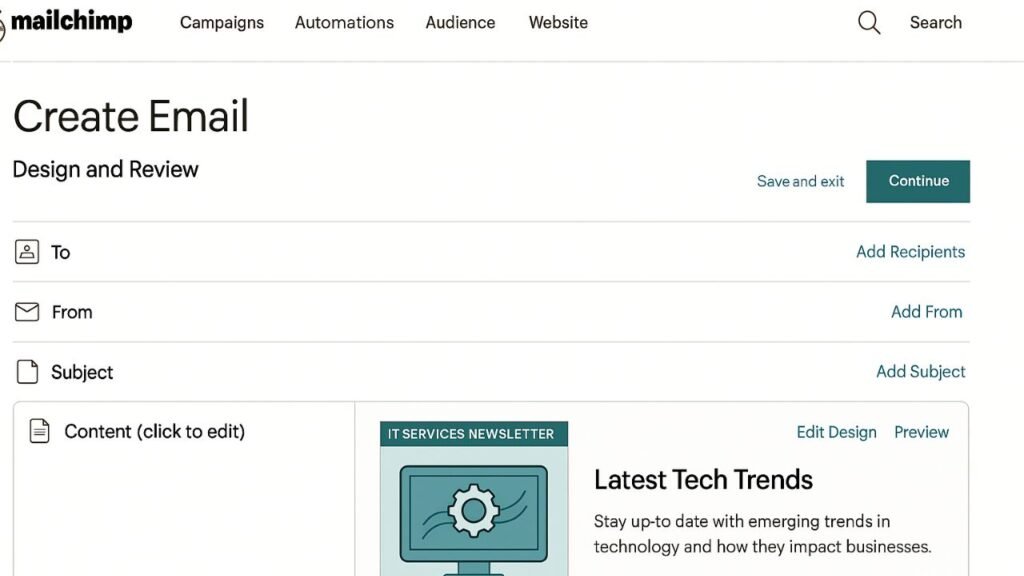
2. MailerLite: Clean Interface Perfect for Tech Companies
MailerLite has gained significant traction among technology companies due to its clean, intuitive design and powerful targeting capabilities. This platform is particularly appealing to IT service providers who appreciate streamlined interfaces and efficient workflows.
Why IT Services Love MailerLite:
- A/B testing capabilities crucial for optimizing technical content and service offerings
- Comprehensive email template library with professional designs suitable for B2B communications
- Advanced popup and form embedding features perfect for lead generation on technical websites
- Seamless integrations with popular tools like Zapier, Typeform, and WordPress
The free plan accommodates up to 1,000 contacts and allows 12,000 emails per month. This generous allocation makes MailerLite ideal for growing IT companies that need room to scale their email marketing efforts.
Advanced Features for Tech Companies:
MailerLite’s premium features, available for just $9 per month, include heatmaps and 24/7 live support – valuable additions for IT companies that operate across different time zones and need detailed performance analytics.
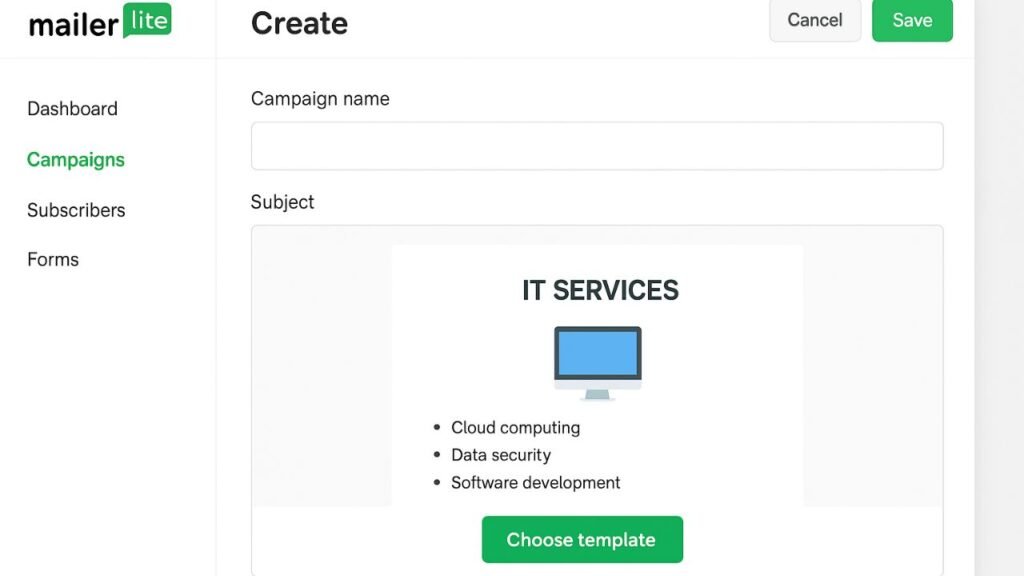
3. Zoho Campaigns: Integrated Email Marketing for IT Services
For IT service providers already using business software suites, Zoho Campaigns offers seamless integration within the broader Zoho ecosystem. This platform is particularly valuable for companies that prefer unified business solutions and need their email marketing to work harmoniously with CRM and project management tools.
Technical Advantages:
- Sophisticated split testing capabilities for optimizing technical content
- Comprehensive analytics reports essential for data-driven IT companies
- Advanced email segmentation perfect for categorizing clients by technical expertise level
- Professional drag-and-drop editor with pre-built newsletter templates
- Robust contact list management suitable for complex IT service offerings
The forever-free plan allows 12,000 emails monthly to 2,000 contacts. However, IT companies requiring marketing automation will need to consider premium plans, which provide advanced workflow capabilities essential for nurturing complex B2B relationships.
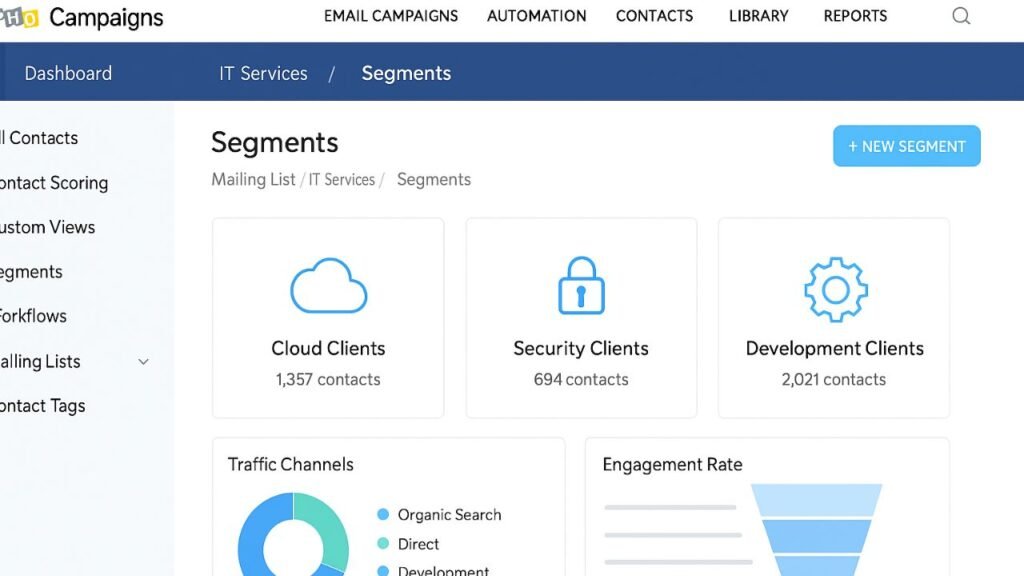
4. Brevo (formerly SendinBlue): Comprehensive Email Marketing for IT Services
Brevo, previously known as SendinBlue, offers one of the most generous free plans in the email marketing space, making it particularly attractive for IT service providers operating on tight budgets. The platform combines email marketing with SMS capabilities, providing multiple touchpoints for client communication.
Standout Features for IT Companies:
- 9,000 free emails monthly – significantly more generous than competitors
- 300 daily email limit with additional SMS credits
- Advanced autoresponder functionality included in the free plan
- GDPR-compliant features crucial for IT companies handling sensitive data
- Multi-channel marketing combining email and SMS for comprehensive outreach
What sets Brevo apart is its inclusion of automation tools in the free plan. This feature is particularly valuable for IT service providers who need to nurture leads through complex sales cycles and provide ongoing technical support communications.
Cost Comparison Advantage:
While Mailchimp’s free plan limits you to 2,000 contacts and charges $50 monthly for 5,000 emails without autoresponder service, Brevo provides 9,000 free monthly emails with automation tools included.
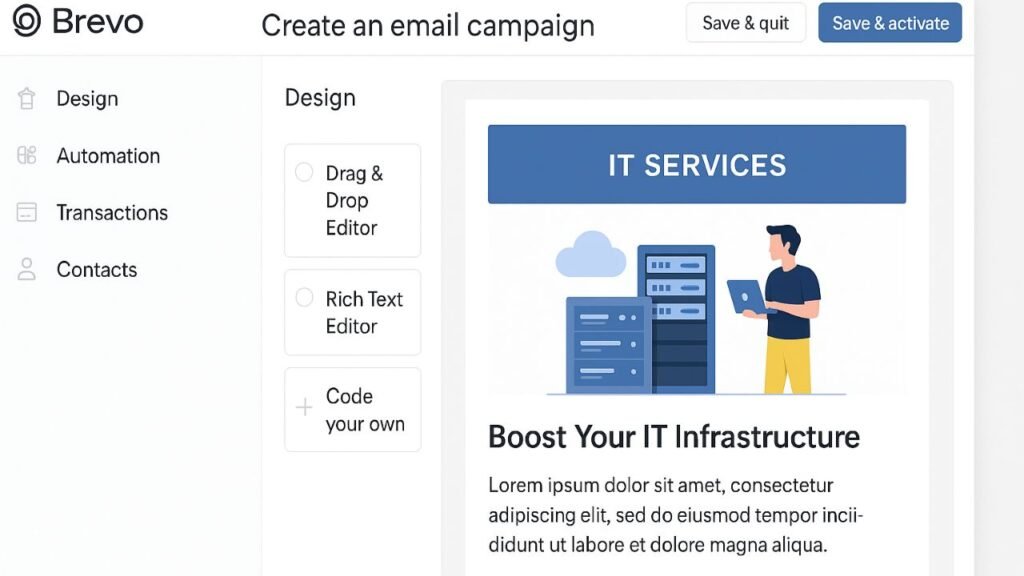
5. EmailOctopus: Budget-Friendly Email Marketing for IT Services
EmailOctopus positions itself as an affordable email marketing solution specifically designed for small businesses, making it perfect for IT startups and growing service providers. Founded in 2015, the company focuses on providing essential email marketing features without unnecessary complexity.
Key Benefits for IT Services:
- 10,000 monthly emails to 2,500 contacts on the free plan
- Advanced email list segmentation perfect for categorizing technical services
- Professional email builder with clean, business-appropriate templates
- Integration with 47+ applications including popular IT and business tools
- Simple interface that doesn’t require extensive training
EmailOctopus is particularly appealing to IT companies that want powerful functionality without the learning curve associated with more complex platforms. The generous free tier allows significant growth before requiring paid upgrades.
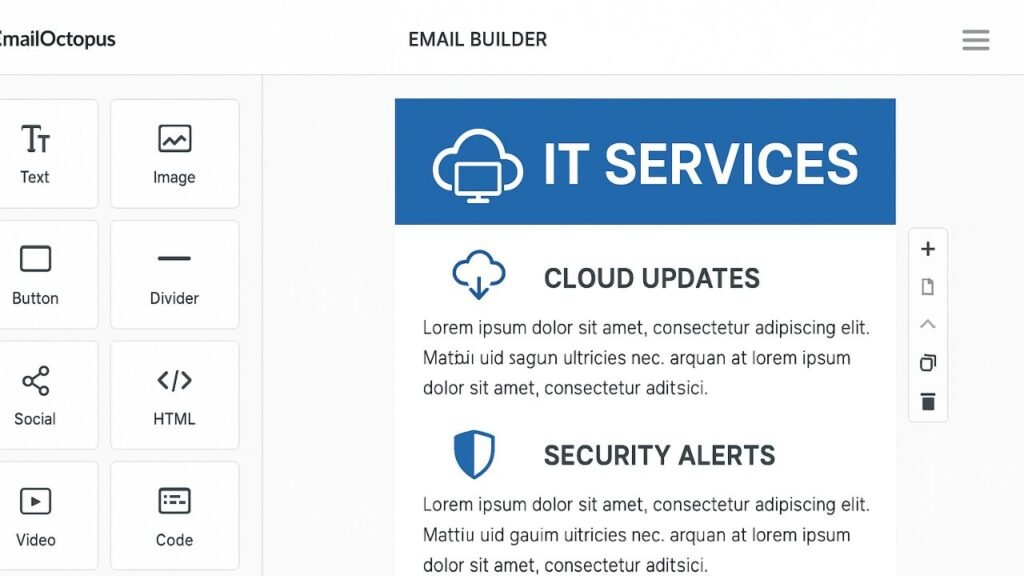
Comparison Table: Free Plan Features
| Platform | Monthly Emails | Contacts | Automation | Key Advantage for IT Services |
|---|---|---|---|---|
| Mailchimp | 2,500 | 500 | Limited | Industry standard with extensive integrations |
| MailerLite | 12,000 | 1,000 | Basic | Clean interface with advanced A/B testing |
| Zoho Campaigns | 12,000 | 2,000 | Premium only | Seamless integration with business tools |
| Brevo | 9,000 | Unlimited | ✓ Included | Most generous automation features |
| EmailOctopus | 10,000 | 2,500 | Basic | Simple setup with powerful segmentation |
Key Considerations for Choosing Email Marketing for IT Services
When selecting an email marketing platform for your IT service company, several factors deserve special attention. Deliverability rates are crucial since IT communications often contain technical terms that spam filters might flag. Additionally, integration capabilities with your existing tech stack can significantly impact workflow efficiency.
GDPR compliance is non-negotiable for IT companies, especially those serving European clients or handling sensitive data. Furthermore, consider the scalability of each platform – while free plans are attractive, ensure the paid tiers align with your growth projections and budget constraints.
The template quality and customization options are particularly important for IT services, as your emails need to convey professionalism and technical expertise. Look for platforms offering industry-appropriate designs that can showcase your services effectively.
Making the Most of Free Email Marketing Plans
To maximize the value of these free email marketing tools, IT service providers should focus on quality over quantity. Rather than sending frequent promotional emails, concentrate on delivering valuable technical insights, industry updates, and educational content that demonstrates your expertise.
Segmentation strategies become particularly important when working with limited monthly email allocations. Consider organizing your contacts by service interests (cloud computing, cybersecurity, software development) to ensure highly targeted communications that drive engagement.
Regular performance monitoring using built-in analytics helps optimize your campaigns over time. Pay attention to open rates, click-through rates, and conversion metrics to refine your email marketing strategy continuously.
Common Email Marketing Mistakes for IT Firms
- Generic blasts: Sending one-size-fits-all emails to your entire list rarely succeeds. If you skip segmentation and personalization, most recipients will tune you out.
- Poor subject lines: Vague or uninteresting subjects lead to low opens. Test and tweak subject lines; a data-backed tweak can lift open rates by 10+ percentage points.
- Ignoring analytics: Failing to track metrics means you don’t learn what works. Always monitor open/CTR and, more importantly, conversion or revenue impact, so you can improve your campaigns each cycle.
- Over-emailing or under-emailing: Bombarding inboxes with daily promos turns people off, but emailing too rarely lets leads go cold. Find a consistent, reasonable frequency (e.g. monthly newsletter, appropriate drip cadence).
- Salesy content: If every email is a sales pitch, recipients will delete or unsubscribe. Prioritize valuable, educational content – aim for an 80/20 ratio (helpful info vs. promotion) to build trust.
- Neglecting deliverability: Not cleaning your list and using spammy language can sink your campaign. Remove inactive addresses and avoid trigger phrases (like “FREE!!!” or all-caps), since about half of emails otherwise never reach the inbox.
- Not mobile-optimized: Many IT decision-makers read email on phones or tablets. Ensure your design is responsive. If users have to pinch/zoom or can’t click buttons easily, they’ll disengage.
For more marketing strategies, including staying organized while managing campaigns, see our Time Management Advice & Tips.
Next Steps and Call to Action
Email marketing for IT services is all about relevance and consistency. Start by auditing your email list and defining clear segments. Plan a content calendar with a mix of the campaign types above (e.g. a monthly newsletter, a drip for new leads, an onboarding series). Use personalization tokens and test your emails to learn what resonates. Monitor your results closely and tweak your approach – email marketing improves with data-driven iteration.
Ready to boost your IT firm’s growth with email? Begin by sending one targeted campaign this week using these tactics. For expert help or to dive deeper, contact us for a consultation or download our free email marketing template. Don’t forget to subscribe to our blog for more practical marketing tips. Let’s make your email marketing really work!




